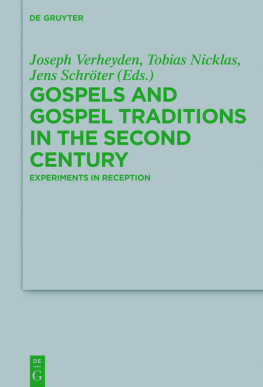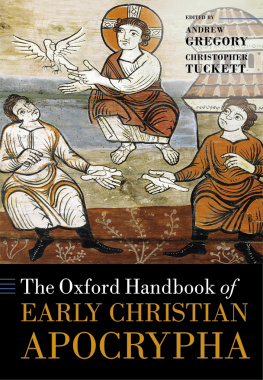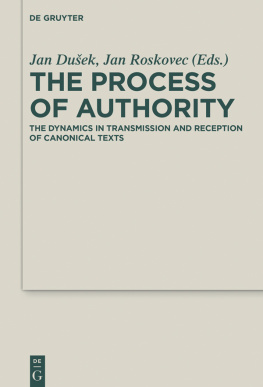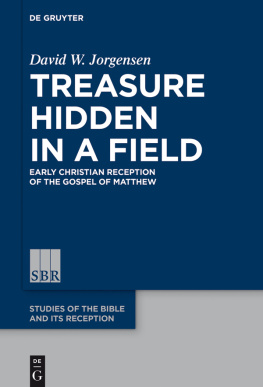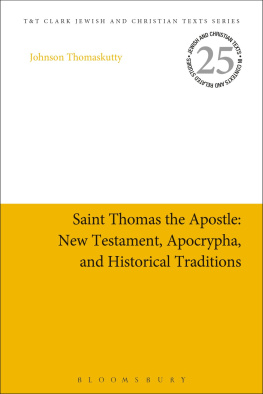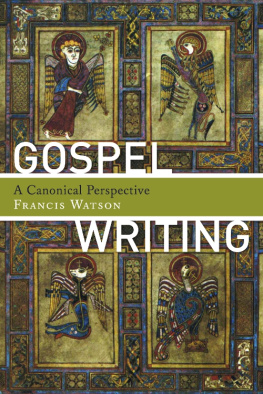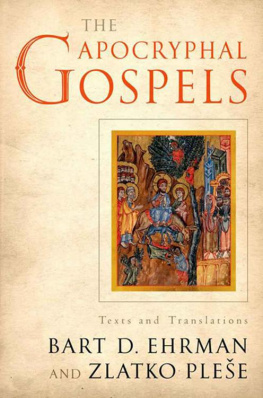Table of Contents
Guide

Gospels and Gospel Traditions in the Second Century
Beihefte zur Zeitschrift fr die neutestamentliche Wissenschaft

Edited by
Matthias Konradt, Hermann Lichtenberger, Judith Lieu, Laura Nasrallah, Jens Schrter and Gregory E. Sterling
Volume 235

ISBN 978-3-11-054081-9
e-ISBN (PDF) 978-3-11-054234-9
e-ISBN (EPUB) 978-3-11-054126-7
ISSN 0171-6441
Library of Congress Control Number: 2018954517
Bibliografische Information der Deutschen Nationalbibliothek
Die Deutsche Nationalbibliothek verzeichnet diese Publikation in der Deutschen Nationalbibliografie; detaillierte bibliografische Daten sind im Internet ber http://dnb.dnb.de abrufbar.
2019 Walter de Gruyter GmbH, Berlin/Boston
www.degruyter.com
Preface
This volume is based on papers presented at the Sixth International Conference of the Leuven Centre for the Study of the Gospels, Leuven, 1517 December 2016. The idea of the conference was to bring together experts on the early Gospel tradition, especially of the second century, to discuss texts which rely in one or another way on earlier Gospels and Gospel traditions and at the same time provide fresh interpretations of the figure of Jesus, his activity and his teaching. The conference as well as the volume with the proceedings of the meeting are intended to contribute to the current debate about the fascinating world of second-century Christianity.
We are grateful to the contributors to the present volume for their participation in the conference, their enduring interest in the topic and the preparation of their papers for publication. A special gratitude is due to Katharina Simunovic, Florian Lengle and Katharina Vetter from the Theologische Fakultt der Humboldt-Universitt zu Berlin who prepared the manuscript for publication and compiled the indexes. Finally, we want to thank the publishing house Walter de Gruyter for taking care of the publication process of the volume in the BNZW series.
August 2018, Jens Schrter, Tobias Nicklas and Joseph Verheyden
Introduction
In recent years the second century has enjoyed a growing interest from scholars working in the field of early Christianity as well as from New Testament scholars. It has been understood as an important and fascinating period for the reception, the transformation and the reinterpretation of the earliest Christian writings, but also for the development of the rituals, ethics and social structure of early Christian communities. By looking more closely at this period, however, the concept of the second century has itself become the object of further scrutiny. The second century is to some degree an artificial notion. Scholars remain divided on the status and importance of this time-span, not at least with regard to the evidence that can be gained from it. The same applies, of course, to such designations as the apostolic age, the post-apostolic era, Urchristentum, early Christianity and the like. All these designations are used side by side in order to come to terms with the developments that shaped this formative period of Christianity. This highlights that there is always a need to discuss the appropriateness of such concepts when it comes to establish the date or study the contents and religious outlook of specific texts and their place in the literary and social history of the first centuries of Christianity.
There is today a widespread agreement that, as a concept, the second century cannot be understood in a strictly chronological sense. It is a period in which some of the writings which later became part of the New Testament were composed, but also such writings that much later were included into a collection called The Apostolic Fathers, and others which are often labelled as non-canonical or apocryphal. It should also be kept in mind that often there are no clear-cut boundaries between Judaism, Christianity, Gnosticism and related categories when it comes to second (and third) century texts. of a period running from the time when Christian faith was first formulated as a distinct view on the God of Israel and his revelation in Jesus Christ up to a stage in which organizational structures of the Christian communities, rituals like baptism and Eucharist and the formulation of central Christian beliefs were solidified.
These (and other) processes, however, should not be regarded as a continous development towards a consolidation of the Christian church. Rather, the second century is characterized by the diversification of Christianity into various strands, a complex relationship of Christianity and Judaism, social formations of different kinds and a broad and diverse reception of philosophical (esp. Platonic) traditions and Jewish texts which were incorporated into thought systems or myths. The second century may therefore be described as a mere transition period between the founding years and the far better documented later centuries, a time of experiments in which much was still possible that would become impossible somewhat later and that seems to escape our attempts at getting grip on it: the decades in which Christianity really opened up to the wider world the second century is all of this, and perhaps even more. Maybe one should even say that it is all of this at the same time, depending on what one is looking for. If anything, it was a period in which major shifts took place and a period that itself has shifted faces over time.
The old divide that basically tried to rein in the writings that would end up in the New Testament to the first century, or the first decade of the second at most (the apostolic era), and considered all that followed as postapostolic has been under fire for years now, and a number of writings that seemed to be secured for the first century are now spreading all over the first half of the second century (e. g., 2 Peter, perhaps also the Pastorals). With regard to the textual transmission of these earliest writings, a vocal minority has defended the view that the second century was the period of everything goes. The written tradition had not yet taken over in the way this would become the case from the third century on; indeed, it looks as if that tradition was itself still in its formative stage and few authors seemed to care about how they cited or referred to the gospels or the letters of Paul. The confidence with which the latter pleaded his case before the political authorities was but a first try and seemed almost amateurish when compared to how the apologists of the mid and late second century addressed the emperor in person. The picture of the loss of the original unity of the Church in the second century as created by second-century authors (Hegesippus, also Justin Martyr) and picked up by later Christian authors (Eusebius of Caesarea) is today no longer accepted, but it remains valid in so far as it points out that this century saw happen the first major breaks and disturbances within the Church to an extent that Pauls quarrels with his opponents did not even foreshadow. In contrast with this, or perhaps as a result of it, the second century also witnesses the rise of the first strong bishops or community leaders, keen on showing their power (moral and managerial) and models and forerunners of some of the heroic figures of later times. The same period also brought us the first attempts at systematizing basic aspects of Christian theology, but perhaps even more so, at exploring more radical approaches to the basic questions this theology raises. There are not just Ignatius shadowy opponents, docetists or not, or Marcion, whatever he actually did, or Tatian, showing a similar urge for doing away with differences, or conservative Jewish-Christian groups, but then also those partially elusive Gnostics, who raised the alarms all through developing mainstream milieus. When looking at the evidence listed here and trying to define this century in terms of periodization, it is perhaps best to call the second century a short century, the starting point of which has become more diffuse than it may have been up to now, while its closing end is perhaps already to be situated in the last two decades when such figures as Irenaeus and Tertullian start showing the way beyond their own time.

